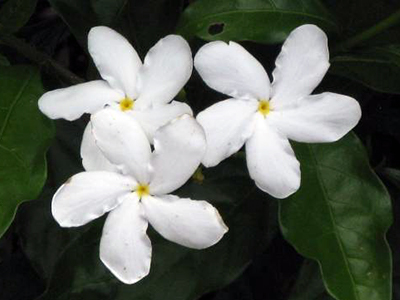Crepe Jasmine

Crepe jasmine is a gorgeous shrub worthy of more use. The abundant flowers are shaped much like a pinwheel, giving this plant another of its common names — pinwheel flower. For the gardener interested in creating a wow-worthy nighttime garden, crepe jasmine fits the bill with white flowers that shine in the moonlight year-round.
Characteristics
Crepe jasmine forms a moderately dense, rounded, evergreen shrub. The spiraling white flowers are particularly prominent in the warmer months of the year, but they stand out against the dark green, glossy evergreen leaves in any season. A double-flowered cultivar called ‘Flore Plena’ exists in the trade. Some gardeners report a light fragrance in the morning and evening, while many others report that it has no fragrance at all.
These plants thrive in USDA Hardiness zones 9B to 11, making it a suitable plant for gardens in Central and South Florida. Mature shrubs reach 6 to 10 feet tall and spread 3 to 6 feet. A hard freeze will kill them back, but they quickly recover.
Planting and Care
Crepe jasmine (Tabernaemontana divaricata) grows in full sun to shade, but they look best when grown in filtered shade. A shrub that that grows densely and flowers in shade is certainly something to be admired. This plant is great for creating a shrubbery border; it also looks good as a specimen plant, and its rounded form makes it a fabulous foundation planting against a windowless wall (it will grow large enough to obscure a window).
Pruning is needed to maintain a more compact form if that is what you desire. These plants thrive in moist, well-drained soil, but grow well with minimal water once well established. Plants perform best in acidic soil; when they are planted in more alkaline soils they made need fertilizer for best results. With this in mind, it’s best to plant crepe jasmine away from concrete as the soil around concrete is usually more alkaline.
The long-term health of crepe jasmine is not affected by insects, diseases, or nematodes, so you can expect to enjoy this shrub for years to come.

